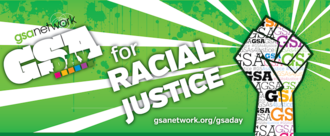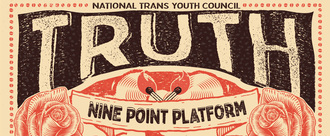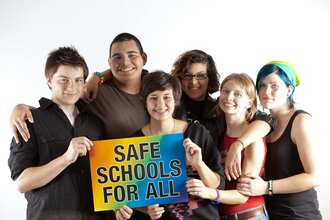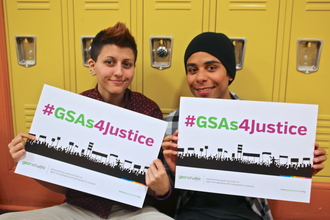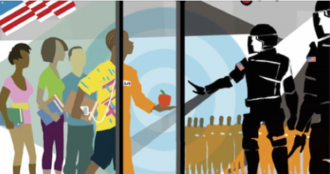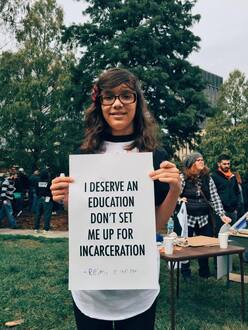- Featured
- Academics
- Accessibility
- Anti-Trans Legislation (State/Federal)
- Art & Mural Projects
- Black Lives Matter in Schools
- Bodily Autonomy
- Book Bans & Curriculum Censorship
- Bullying & Harassment
- Climate Justice
- Community GSA Formation
- Culturally Responsive Curriculum
- Discipline & Surveillance Policies
- Dress Code Reform
- Events & Celebrations
- Free Palestine / Anti-Occupation Solidarity
- Immigration Justice / Abolish ICE
- Inclusive Sex-Ed
- Indigenous Sovereignty & Land Back
- Language Justice/ Multilingual Access
- LGBTQ-Inclusive Curriculum
- Mental Health Access
- Police Free Schools
- Restroom & Locker Room Access
- School Budgets & Resource Allocation
- School Clubs (GSAs, Affinity Spaces)
- Student Loan & College Access Reform
- Student Media & Free Expression
- Substance Free/Harm Free Zones
- Teacher & Staff Accountability
- Transgender Youth Rights
- Visibility & Pride/GSA Days
- Voting Rights & Youth Civic Power
- Youth Labor & Economic Justice
- Youth Leadership & Decision Making
- More
-
UNITYIt is important because LGBT and especially Black LGBT people are not treated equally in our world. We want to continue to make positive changes in our school. People require counseling and more conversations around diversity, discrimination and LGBT rights should happen within our school.30 of 100 SignaturesCreated by Unity G.

-
What We Deserve: How schools can support trans and queer youth of colorWE DESERVE 1) Public school systems that have funding regardless of local property tax or proximity to wealthy, white communities. 2) Police-free schools without armed guards or armed teachers. 3) Schools with GSAs (or other student-led convening spaces). 4) Administrators and Teachers who are POC, trans and queer. 5) Administrators, Teachers and Staff with annual Racial and Gender competency training. 6) Black, Indigenous, Latinx, Asian, and LGBTQIA relevant curriculums with Fine Arts and Advanced Placement courses that reflect our diverse and ancient cultures. 7) Multiple full-time nurses and full-time social workers at our schools. 8) Schools with Trans and Queer Youth of Color Student Government Committees164 of 200 SignaturesCreated by National Youth Council o.

-
The Fight Against Transphobia in LBUSDThis is important because not only is this affecting me but I also want future students who come to any of the LBUSD schools to know that they are protected under state, federal, local, and district laws. People deserve to know that we in the transgender community are here no matter what anyone says. #WEWILLNOTBEERASED Being able to collect even the smallest amounts of signatures will help us get far and start a movement. I strongly believe the treatment the transgender community has received is a disgrace. Having been through personal struggles, I am taking a stand and want my voice heard.579 of 600 SignaturesCreated by Amber V
-
Sign onto the National Trans Youth Council's Nine Point PlatformWe cannot break the chains that bind us if we do not strive for a world without the very systems that put them on our wrists. We cannot work alone towards this goal either, because no one struggles alone; the white, heterosexual and cisgender patriarchy harms all us. When LGBTQ+ youth come together, when the most marginalized of us are uplifted, and when those more privileged acknowledge and use it for the fight, our community has a voice that will not be silenced and the power to create a just world for all.155 of 200 SignaturesCreated by Juniperangelica Gia L.
-
We need a GSA at North Whitfield Middle School!My middle school experience was filled with some hate and bullying at the start until I found a couple of people like me. We started talking about starting a petition and even went to our school counselor about it. We didn't think about it that much afterwards so it was forgotten about. A couple of months later the idea came back to me and I decided to go all the way with it. A Gay-Straight Alliance (GSA) club would provide a much-needed safe place for students to meet, support each other, talk about issues related to sexual orientation and gender identity, and work to create positive change on campus. Under the Federal Equal Access Act (http://www.gsanetwork.org/equal-access-act), any school that receives government funding and has at least one other non-curricular club is legally required to also allow a GSA. Legally, public schools with other clubs must let students start a GSA -- and must treat the GSA like any other student club! Schools can't make up rules that only apply to the GSA and nobody else. GSAs have been proven to make schools safer for all students. Allow us to start a GSA so that ALL students can succeed.31 of 100 SignaturesCreated by Bradley M.
-
Gender Nuetral Bathrooms in Maine SchoolsThis is important because of the increase in attacks, bullying, mistreatment, and more in Maine high schools, originating mostly in bathrooms, as they have no cameras.20 of 100 SignaturesCreated by Nora G.
-
Update NNPS Non-discrimination policy!Our student and staff populations have changed tremendously in the almost 20 years since this policy was last updated. We have become a more diverse city and a more diverse school system. In many ways, we acknowledge, accept, support, include and celebrate our diversity in our schools. Our policies should also PROTECT this diversity in all of its forms. According to a recent study (GLAAD’s third annual Accelerating Acceptance report), 20% of millennials and younger identify as LGBTQ, and 12% of millennials and younger identify as either transgender or gender-nonconforming. These are significant numbers. Statistically speaking, this means that, of our approximately 8,000 students in grades 9-12 alone, 1,600 of them likely identify (publicly or privately) as LGBT, and almost 1,000 identify (publicly or privately) as transgender or gender non-conforming. Of our approximately 4,700 district employees, it is likely that as many as 700-900 openly or privately identify as LGBTQ individuals. Due to Attorney General Mark Herring’s 2015 opinion on school boards’ authority, localities ARE able to enact nondiscrimination policies that include sexual orientation and gender identity. This gives school boards the authority to protect students and employees through policy updates. According to Equality Virginia, today more than 25% of Virginia’s public school students and employees are protected based on their sexual orientation and gender identity or expression. These protections now exist in 53 counties and 18 independent cities in our Commonwealth. Sadly, Newport News students and staff are not among them. Our LGBTQ students and staff members deserve these protections against discrimination.16 of 100 SignaturesCreated by Charlie J.
-
Matawan Aberdeen Regional School DistrictIn November 2013, Jewlyes Gutierrez, a transgender girl from California, was outrageously charged with assault for defending herself against bullying at school. A year earlier, Dynasty Young in Indiana was expelled for bringing a stun gun to school in self-defense after enduring months of harassment based on his sexual orientation and gender expression. Jewlyes, Dynasty, LGBTQ youth, and all students deserve better. Our district can -- and must -- take action now to make sure our students are never put in a similar position. We often hear about bullying in schools, but the anti-bullying and zero tolerance policies adopted in response pose just as much of a danger for LGBTQ youth of color. Together, hostile school environments and extreme disciplinary policies create a school-to-prison pipeline for youth of color, youth with disabilities, and LGBTQ youth, telling them that their lives are disposable and that simply trying to get an education carries a risk of jail time. LGBTQ youth make up just 5-7% of the youth population, but represent 15% of those in the juvenile justice system. Exclusionary practices (like suspensions and expulsions) hurt all students' ability to succeed and achieve their academic goals and dreams. We believe restorative justice practices are the best solution for school discipline problems involving bias-based bullying and harassment, because they allow schools to address the root problems behind bullying and harmful behavior. In January, the Obama administration released guidelines for improving school climate and discipline. Those guidelines recommend best practices like restorative approaches and condemn punitive policies and court referrals. It has been proven that alternative discipline with non-punitive approaches provides better student outcomes and keeps the student community together. In March 2014, the National Education Association, the American Federation of Teachers, the Opportunity to Learn Campaign, and the Advancement Project jointly released a toolkit highlighting restorative approaches as a best practice and providing guidance to administrators and educators on implementing them. In order to keep ourselves and fellow students in school, we demand that restorative justice practices, as outlined in the "Restorative Practices: Fostering Healthy Relationships & Promoting Positive Discipline in Schools" toolkit, be implemented in our district.19 of 100 SignaturesCreated by Emilly H.
-
SGV LGBTQ Students Need Solutions: Adopt Restorative PracticesIn November 2013, Jewlyes Gutierrez, a transgender girl from California, was outrageously charged with assault for defending herself against bullying at school. A year earlier, Dynasty Young in Indiana was expelled for bringing a stun gun to school in self-defense after enduring months of harassment based on his sexual orientation and gender expression. Jewlyes, Dynasty, LGBTQ youth, and all students deserve better. Our district can -- and must -- take action now to make sure our students are never put in a similar position. We often hear about bullying in schools, but the anti-bullying and zero tolerance policies adopted in response pose just as much of a danger for LGBTQ youth of color. Together, hostile school environments and extreme disciplinary policies create a school-to-prison pipeline for youth of color, youth with disabilities, and LGBTQ youth, telling them that their lives are disposable and that simply trying to get an education carries a risk of jail time. LGBTQ youth make up just 5-7% of the youth population, but represent 15% of those in the juvenile justice system. Exclusionary practices (like suspensions and expulsions) hurt all students' ability to succeed and achieve their academic goals and dreams. We believe restorative justice practices are the best solution for school discipline problems involving bias-based bullying and harassment, because they allow schools to address the root problems behind bullying and harmful behavior. In January, the Obama administration released guidelines for improving school climate and discipline. Those guidelines recommend best practices like restorative approaches and condemn punitive policies and court referrals. It has been proven that alternative discipline with non-punitive approaches provides better student outcomes and keeps the student community together. In March 2014, the National Education Association, the American Federation of Teachers, the Opportunity to Learn Campaign, and the Advancement Project jointly released a toolkit highlighting restorative approaches as a best practice and providing guidance to administrators and educators on implementing them. In order to keep ourselves and fellow students in school, we demand that restorative justice practices, as outlined in the "Restorative Practices: Fostering Healthy Relationships & Promoting Positive Discipline in Schools" toolkit, be implemented in our district.12 of 100 SignaturesCreated by Iain S.
-
Pass Ohio Senate Bill 34: End Zero Tolerance Now!Zero tolerance policies in Ohio Schools have been shown to negatively affect everyone in our communities, and disproportionately harm youth of color, LGBTQ+ youth, and students with disabilities. The spirit of Ohio schools should be one of caring, stability, and support for ALL students. According to testimony from Ohio Senator Tavares on March 17, 2015: "A disproportionate number of the total number of disciplinary incidents in Ohio public schools affected black students and students with disabilities. Black students in Ohio public schools for the 2012-13 school year accounted for 52 percent of all suspensions and 53 percent of all expulsions, even though black students comprise only 15.9 percent of students enrolled in Ohio schools. Students with disabilities account for 27.5 percent of all suspensions, but only 14.8 percent of total enrollment. Black students are over 6 times more likely to be suspended than white students, and students with disabilities are approximately twice as likely to be suspended. Students with emotional disturbance - a certain category of disability under the Individuals with Disabilities Education Act - however, are over 6 times more likely to be suspended. And if you put race and disability together, a black student with emotional disturbance is 25 times more likely to be suspended than a White student with no disability." Additionally, the ACLU released a report demonstrating how zero tolerance policies harm all youth, especially LGBTQ+ students. The report concluded that zero tolerance policies: -"DON’T improve school safety or climate. The assumption behind Zero Tolerance policies is that removing disruptive students from school will deter other students from disruption and create an improved school climate. But research shows that the opposite is in fact true—schools with high suspension and expulsion rates have worse school climates and higher rates of suspension and misbehavior. -DON’T stop the bullies from bullying. Suspension and expulsion don’t result in changed behavior, and they could lock in that behavior. Studies of school suspension show that up to 40% of school suspensions are for repeat offenders, leading researchers to conclude that, for those students, 'suspension functions as a reinforcer...rather than a punisher.' -ARE used against LGBTQ students more than straight students. Research also shows that Zero Tolerance policies are disproportionately used against vulnerable student populations, including students of color, students with disabilities, and LGBTQ students. A recent study concluded that LGBTQ students were 1.25 to 3 times more likely to get punished at school than their heterosexual peers. What this means is that the LGBTQ student who fights back against bullying is more likely to be punished than the bully." Introduced by Senator Tavares and sponsored by Senators Seitz, Brown, Thomas, and Skindell, SB34 will: "Eliminate any policy of zero tolerance for violent, disruptive, or inappropriate behavior, including excessive truancy, adopted under this section as it existed prior to the effective date of this amendment. Thereafter, no board shall adopt or readopt any policy of zero tolerance for such behavior. Each board shall instead adopt a policy that allows for many factors to be considered prior to the suspension or expulsion of a student. The policy shall establish alternative strategies, including prevention, intervention, restorative justice, peer mediation, and counseling to address both of the following: (1) Discipline for student behavioral problems; (2) Harassment, intimidation, and bullying, as defined by section 3313.666 of the Revised Code."93 of 100 SignaturesCreated by Brandon H.
-
Help Me Fight Against Schools Punishing People For Standing Up for What's RightSchools shouldn't punish students for standing up for justice. I was fighting for my civil rights and my rights as a human being and that is why the issues surrounding Ferguson and Racism itself are important to me. I believe the school also needs to adopt better alternatives other than suspension, expulsion, and detention because this is not helping people's education but set them up for things like incarceration and pushing them away from school. This is not the first time that people of color have been unfairly targeted. We have been punished more than most of the white kids have been even though we are not behaving worse. It is important to work together and find solutions and it has been proven that current punishments do not work. Not only am I targeted but people with disabilities, other people of color, people who Identify as trans*, and much more are affected by schools current practices. We need to work together.338 of 400 SignaturesCreated by Reimi C.
-
North Carolina Students Need Solutions: Adopt Restorative PracticesIn November 2013, Jewlyes Gutierrez, a transgender girl from California, was outrageously charged with assault for defending herself against bullying at school. A year earlier, Dynasty Young in Indiana was expelled for bringing a stun gun to school in self-defense after enduring months of harassment based on his sexual orientation and gender expression. Jewlyes, Dynasty, LGBTQ youth, and all students deserve better. Our district can -- and must -- take action now to make sure our students are never put in a similar position. We often hear about bullying in schools, but the anti-bullying and zero tolerance policies adopted in response pose just as much of a danger for LGBTQ youth of color. Together, hostile school environments and extreme disciplinary policies create a school-to-prison pipeline for youth of color, youth with disabilities, and LGBTQ youth, telling them that their lives are disposable and that simply trying to get an education carries a risk of jail time. LGBTQ youth make up just 5-7% of the youth population, but represent 15% of those in the juvenile justice system. Exclusionary practices (like suspensions and expulsions) hurt all students' ability to succeed and achieve their academic goals and dreams. We believe restorative justice practices are the best solution for school discipline problems involving bias-based bullying and harassment, because they allow schools to address the root problems behind bullying and harmful behavior. In January, the Obama administration released guidelines for improving school climate and discipline. Those guidelines recommend best practices like restorative approaches and condemn punitive policies and court referrals. It has been proven that alternative discipline with non-punitive approaches provides better student outcomes and keeps the student community together. In March 2014, the National Education Association, the American Federation of Teachers, the Opportunity to Learn Campaign, and the Advancement Project jointly released a toolkit highlighting restorative approaches as a best practice and providing guidance to administrators and educators on implementing them. In order to keep ourselves and fellow students in school, we demand that restorative justice practices, as outlined in the "Restorative Practices: Fostering Healthy Relationships & Promoting Positive Discipline in Schools" toolkit, be implemented in our district.9 of 100 SignaturesCreated by Christy B.
.png)

